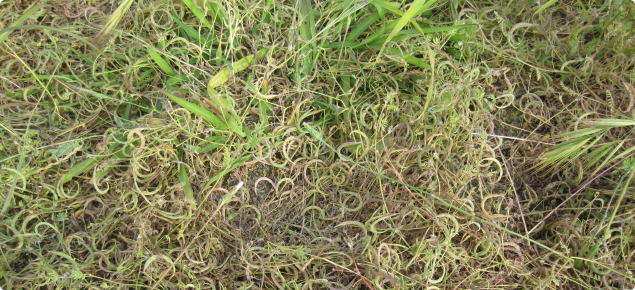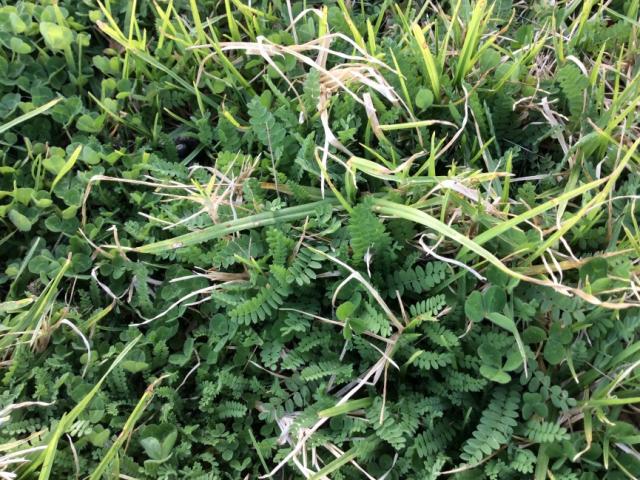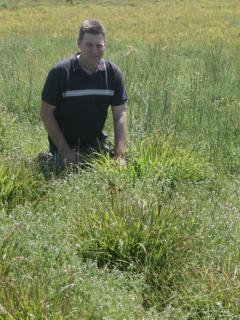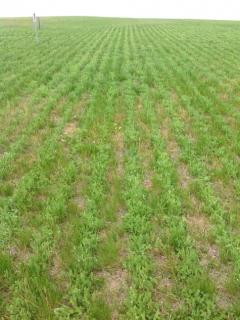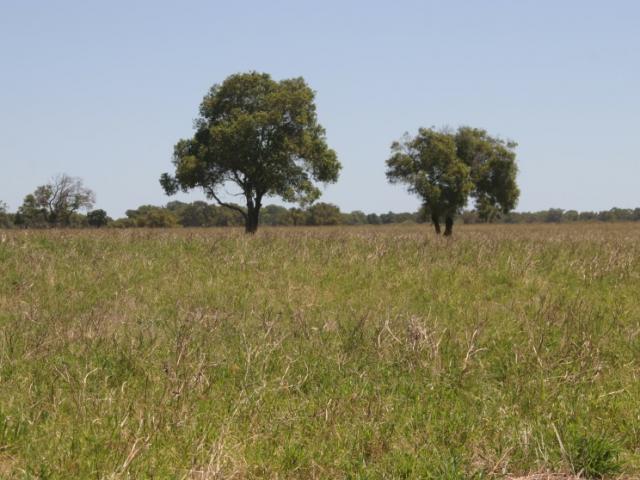On the sandy soils where the perennial grasses are predominantly grown in the Northern Agricultural Region (NAR) the main annual legume options are yellow and French serradella and blue lupins. On the same soils across the South Coast (SC) the sub-tropical grass kikuyu is mostly grown with subterranean clover, with the exception of deep sands where it is best partnered with yellow or French serradella.
The use of sub-tropical perennial grasses in both the NAR and SC continues to increase, especially on sandy soils which are marginal or unsuitable for cropping. However, many perennial grass pastures have a low or highly variable legume content which limits both pasture and livestock productivity. Annual legumes are generally best suited as companion species for the sub-tropical grasses, as their growth pattern is complementary, whereas perennial legumes are unlikely to be persistent and will compete with the sub-tropical grasses for soil moisture following out-of-season rainfall.
Annual legume options
The annual legume options for sub-tropical perennial grasses are the same as those for annual pasture systems on the same soils. However it is worth considering an earlier flowering variety due to strong grass competition for moisture in spring resulting in a shorter season in some years. On the sandy soils where the perennial grasses are predominantly grown the main annual legume options are subterranean clover, yellow and French serradella and for some situations in the NAR blue lupins (Table 1).
| Companion annual legume options | Yellow and French serradella | Blue lupins | Subterranean clover | Balansa clover |
|---|---|---|---|---|
| Minimum annual rainfall (mm) | 325 | ~450* | 350 | 350 |
| Soil pHCaCl2 | 4.0-7 | 4.0-7 | 4.3-7.5 | 4.7-7.2 |
| Pale deep sands | √ | √√ | X | X |
| Yellow deep sands | √√ | √√√ | √ | X |
| Shallow sandy duplex soils | √ | X | √√√ | X |
| Deep sandy duplex soils | √√√ | √√√ | √√ | X |
| Gravelly duplex soils | √√√ | √√ | √√√ | X |
| Ironstone gravelly soils | √ | X | √√ | X |
| Winter waterlogged soils | X | X | √√** | √√ |
(Key: X- unsuitable; √ – marginally suitable; √√ – suitable; √√√ – highly suitable)
* Susceptible to frosts, so growth limited by frosts rather than rainfall per se
** Subspecies yanninicum has a high waterlogging tolerance (providing rainfall >425mm)
Subterranean clover
Subterranean clover is a grazing tolerant annual pasture legume which is a proven companion for kikuyu on the SC, except on deep sands. In general where subterranean clover can be grown then it will be more persistent and produce more biomass under regular grazing than the alternative annual legumes. Many kikuyu stands on the SC have a high clover density and are more productive than annual pastures. In the NAR subterranean clover is poorly adapted to most of the soils used for growing sub-tropical grasses.
A range of cultivars are available for areas ranging from 275 to 1200mm average annual rainfall. Subterranean clover has three subspecies (ssp): – ssp. subterraneum is adapted to well-drained, moderately acidic soils; ssp. yanninicum to moderately acidic soils with poor drainage; while ssp. brachycalycinum is best suited to neutral-alkaline, cracking clay or stony soils and generally fails to persist on Western Australian (WA) soils.
Subterranean clover has several features that make it well adapted as a companion legume: it tolerates regular, close grazing (particularly set-stocking by sheep) due to its prostrate growth habit, buries its burrs to protect seeds from being eaten by stock and maintains a seed bank of ‘hard’ seeds, enabling regeneration after pasture cropping or a year with little or no seed-set.
Weaknesses include a shallow root system, susceptibility to redlegged earth mites (RLEM), particularly at the seedling stage and in dry years on the SC kikuyu competes strongly for soil moisture and can exacerbate the effect of a false break leading to failed or poor establishment of subterranean clover.
Managing subterranean clover in kikuyu pastures
The key to managing subterranean clover in kikuyu stands is to maintain a good clover density and soil seed bank. This requires that grazing pressure is applied to kikuyu before the break of the season to keep the sward open, adequate soil fertility for the clover and RLEM control as required. If these tactics prove insufficient then suppression of kikuyu with a grass selective herbicide such as clethodim following the break of season can substantially lift legume content by reducing kikuyu competition.
If stands have an inadequate clover seed bank a combination of grass suppression and re-seeding will successfully re-establish subterranean clover.
Cultivar characteristics
A range of cultivars are available for areas ranging from 275 to 1200mm average annual rainfall. Flowering time is the most important character that determines cultivar persistence in an environment, as it determines the amount of seed that can be set. Other features to consider when selecting a variety include oestrogen levels, hardseededness, disease resistance and redlegged eath mite resistance.
As a companion legume mixing two or more cultivars with up to two to three weeks difference in flowering time is one way to account for seasonal differences and the competition from kikuyu in spring.
Serradella
There are two main species of serradella grown in WA; yellow serradella and French serradella. They can both produce an extended period of green feed in spring compared to most annual legumes due to their indeterminant growth habit and deep root system.
The strengths of serradella include: adaptation to deep infertile sandy soils, acid soil tolerance (pHCa>4.0), high palatability to stock with excellent nutritive value and no major anti-nutritional properties, good tolerance to RLEM and aphids and the ability to harvest seed on-farm.
Weaknesses include susceptibility to native budworm during seed production, some susceptibility to lucerne flea, limited broadleaf weed control options with selective herbicides and unsuitable for soils with an alkaline pH.
Results from field trials and commercial paddocks in the NAR demonstrate that serradella can be a highly persistent and productive companion legume for sub-tropical grasses – refer to Highly productive sub-tropical grass—serradella pastures.
Seed bank dynamics
The persistence of annual pasture species relies on regeneration from the seed bank, so an understanding of seed bank dynamics, in particular hard-seed breakdown and the subsequent germination patterns is useful.
Hard-seed breakdown (or seed softening) occurs in response to large diurnal changes in soil temperature over the summer–early autumn period; e.g. high temperatures 40-60°C during the day followed by mild temperatures at night. However, there are not only differences in the proportion of seed softening between species, but also in the timing of hard-seed softening.
For example, in subterranean clover almost all the hard-seed breakdown for that year has occurred by mid-March and the seed is then ready to germinate. Yellow serradella and hard-seeded French serradella behave quite differently, while the ‘Cadiz (Plant Breeder's Rights - PBR)’ and ‘Eliza (PBR)’ varieties of French serradella are nearly 100% soft-seeded (i.e. all of the seed is ready to germinate once the plant senesces).
‘Margurita (PBR)’ and ‘Erica’ are hard-seeded French serradella varieties, with about 40-60% of seed softening each year. Seed softening occurs gradually over an extended period from late summer through to late autumn. Erica is not widely used and there is limited availability of seed.
The commercial varieties of yellow serradella developed for use in cropping systems - i.e. Santorini, Charano, Yelbini (PBR) - have a high proportion of hard-seed which will persist for more than one year in the soil, with <30% of the seed softening in any one year. As a result, regeneration of these yellow serradella varieties will be poor in the year after sowing due to the high hard-seed content.
There are also differences between varieties as to when the ‘softened’ seed will germinate. The commercial varieties of yellow serradella developed for cropping systems have varying degrees of delayed germination after the onset of moist soil conditions, while hard-seeded French serradella germinates within the first 10 days providing the soil moisture is adequate (e.g. seed not sitting in a pocket of non-wetting sand). Santorini yellow serradella has the most protracted germination pattern which extends out to 40 days.
| Species / variety | Days to flowering | Rainfall zone (mm) | Annual hard-seed breakdown | Suitability summer sowing | Protracted germination pattern | Likely persistence in medium-term |
|---|---|---|---|---|---|---|
| Cadiz1, Eliza2 (French serradella) | 1101, 902 | 350−5001 300−4002 | NA (100% soft seeded) | No | No | X |
| Margurita, Erica (French serradella) | ~115 | 450−650 | 40-60% | Yes | No | √√ |
| Avila (Yellow serradella) | 120 | 600-750 | 40-60% | Yes | No | √√√ |
| Santorini, Charano, Yelbini (Yellow serradella) | 80−110* | 350-600 | <30% | No | Yes** | √√√ |
1,2 link each cultivar to flowering time and target rainfall zone
*Days to flowering when grown in Perth are Santorini 105-110 days; Charano ~95 days and Yelbini ~80 days
**Varies with variety, Santorini has the most protracted germination (up to 40 days)
PBR varieties include Cadiz, Eliza, Margurita and Yelbini.
Yellow and French serradella are somewhat similar species, but yellow serradella is a more robust plant and more likely to persist in the medium and long-term. Hard-seeded French serradella is a more ‘showy’ plant and can give good production in the first couple of years, but there are questions about its persistence in the medium-term (Table 2). In pasture-cropping rotations regular re-seeding is expected, but with good management perennial grasses are productive in the long-term (>15 years) and ideally the companion legume would also persist in the medium- to long-term.
Blue lupins (suited only to NAR)
Blue lupins, also called sandplain lupins are a deep-rooted, self-regenerating annual legume well suited to the infertile sandy soils in the coastal belt of the NAR.
Blue lupins are somewhat maligned, but do have some strengths as they are: a productive legume for infertile sands, have high stubble value as a stock feed over summer, provide nitrogen for companion plants, are tolerant of false breaks and have a lower nutrient requirement than subterranean clover.
However, blue lupins also have a number of limitations including low palatability when green, animal health risks due to alkaloid toxicity when green and the potential for lupinosis in summer following rainfall. Blue lupins can also exacerbate non-wetting problems of sandy soils, shade out other pasture species if left dense and ungrazed, are susceptible to frosts and waterlogging and very susceptible to anthracnose. The seed pods shatter on maturity, so harvestability is an issue.
Overall, the use of blue lupins is best restricted to very infertile sands in the NAR where serradella does not grow well.
Perennial legume options
A number of perennial legumes have been evaluated in field trials or by producers, but in general their potential role as companion legumes is limited:
- Strawberry clover is a waterlogging tolerant perennial clover normally grown in temperate, high rainfall environments – it is only an option in niche environments where there is sub-surface fresh water within the root zone.
- Lucerne is marginally adapted to the climate in the NAR and poorly suited to the sandy soils predominantly used for growing sub-tropical grasses.
- Lotononis is a sub-tropical perennial legume adapted to sandy soils, but the very small seed size makes establishment problematic as the emerging cotyledons are often buried by sand in-fill.
- Tropical perennial legumes (eg. siratro, burgundy bean, stylo) – all require the combination of good soil moisture and warm to high temperatures for growth as they are more ‘tropical’ than the warm season grasses. These conditions are only experienced following summer rainfall, so biomass production and therefore nitrogen fixation is generally very low.
Methods of establishment
The main two methods for establishing annual legumes into perennial grass pastures are summer sowing or conventional seeding after the break of season.
Summer sowing refers to sowing pod (or unscarified seed) in late summer–early autumn. Companion annual legume options suitable for summer sowing include:
- Margurita (PBR) and Erica French serradella (pod)
- Avila yellow serradella (pod) – higher rainfall (>600mm) areas only.
Refer to guidelines for summer sowing serradella into perennial grass pastures; Highly productive sub-tropical grass—serradella pastures.
Conventional sowing refers to sowing seed after the break of season following full weed control and if required suppression of the sub-tropical grass through grazing or the use of herbicide. All of the annual legume options can be sown from seed including the hard-seeded yellow serradella varieties which are unsuitable for summer sowing.
Inoculant
For new sowings it is recommended to inoculate with the correct Rhizobia: i.e. Group C for subterranean clover and Group S for serradella. Options include the lime pelleting of seed using a peat-based or freeze-dried inoculant or drilling a granular inoculant with the seed (refer to Inoculating pasture legumes).
Re-establishing subterranean clover from an existing seed bank
A high proportion of kikuyu pastures on the SC have a viable subterranean clover seed bank, yet frequently contain a low clover content, usually as a result of competition from kikuyu, insect pests or low soil fertility. Methods to increase legume content in these swards, without re-seeding include:
- Apply sufficient grazing pressure to kikuyu particularly in autumn, before the break of season, to reduce thatch and allow clover seedlings to establish.
- Control RLEM - The new cultivars, Rosabrook (PBR), Narrikup (PBR), Bindoon (PBR), Tammin (PBR) and Forbes (PBR) have increased cotyledon resistance to RLEM. However, resistance is not absolute and pesticides should be used at seeding and also in regenerating pastures when RLEM densities are high.
- Improve soil fertility (phosphorus, potassium) − based on soil test results.
- Suppress kikuyu using a grass selective herbicide when the clover seedlings are establishing.
Acknowledgements
This research was co-funded by the Department of Primary Industries and Regional Development (DPIRD), Meat and Livestock Australia (MLA) and the Grains Research and Development Corporation (GRDC) EverCrop project. We acknowledge Dr Brad Nutt (Murdoch University) for information on the seed dynamics of serradella and Dr Phil Nichols for information on subterranean clover.
(PBR) denotes pasture cultivars that are protected under Plant Breeder's Rights legislation. Unauthorised propagation of seed for commercial purposes or sale of these cultivars is an infringement under section 53 of the Plant Breeders Rights Act 1994 and is subject to prosecution.

